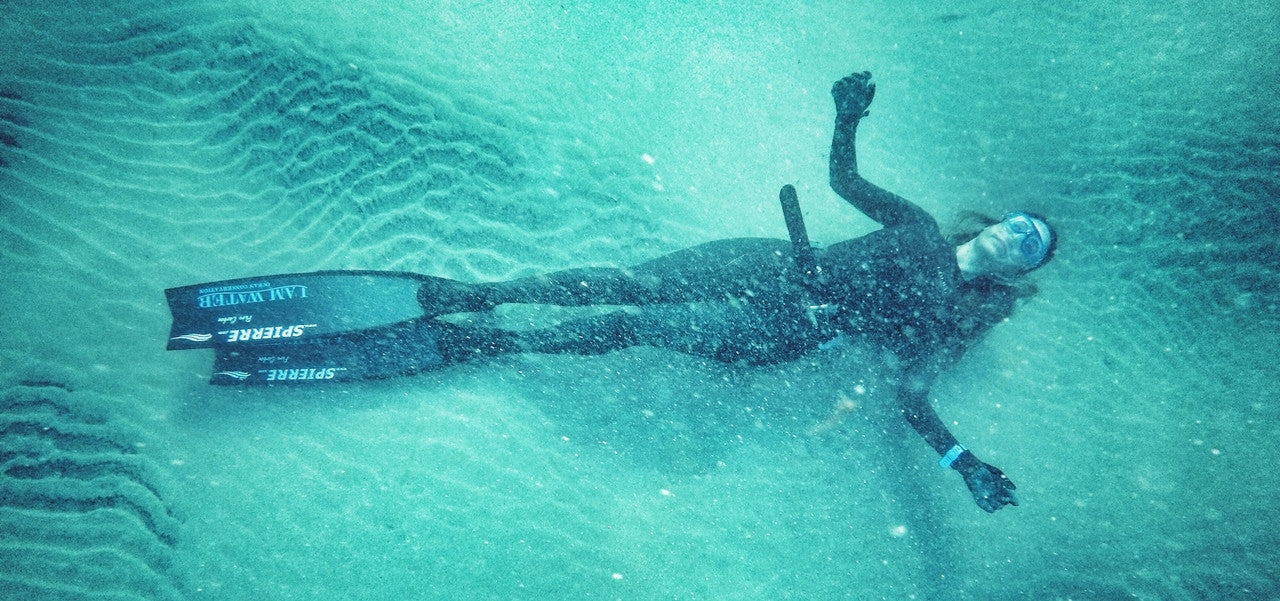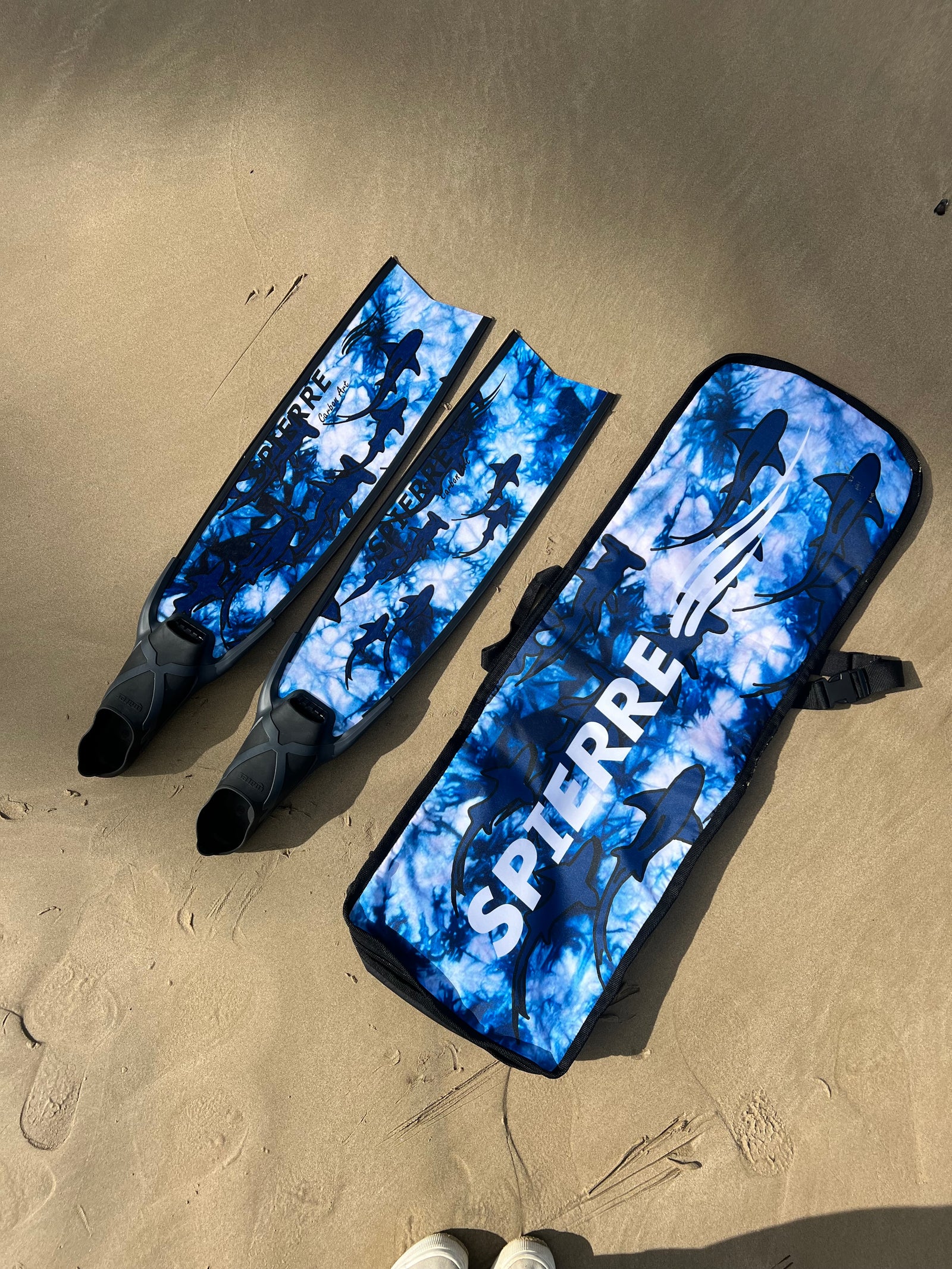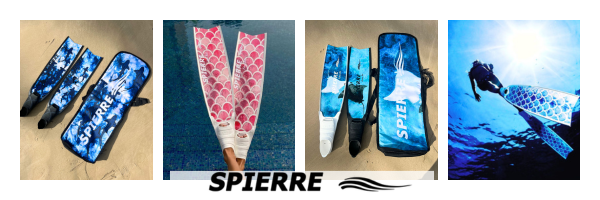How to select the best fins for Spearfishing and Freediving

The value of a good spearfishing fin cannot be over emphasized and a good quality fin is probably one of the most overlooked pieces of dive equipment. If you consider that our time spent hunting while free diving underwater takes place in a foreign and sometimes harsh environment and without the niceties of inbuilt aquatic fins to propel us effectively in the deep, our free diving fins become our greatest asset (or liability) in effective underwater propulsion and safety. From the many hours spent designing and manufacturing blades and discussing our customer’s varying fin needs and questions they’ve asked, here’s an overview on the different types of blades and the design options available.
There are three basic materials used in the construction of spearfishing blades. The first type is Plastic, also referred to as polypropylene or thermoplastic blades.
These blades are generally mass-produced in molds and can either be permanently fixed to the rubber foot pocket or they can be removable, allowing you to interchange the blades in some models. Buying a fin with a removable blade and universal foot pocket is a good investment as you can later upgrade to composite blades or even carbon fiber. Plastic blades are good entry-level blades and will work well under most conditions. These blades are normally bought off the shelf in the stiffness available and are usually the most cost-effective blades although some brands can be more expensive than even fiber composite blades.
Next are Fiber Composite, Carbon and Pure Carbon blades that can be grouped in a blade category called Composites.
Fiber Composite blades - constructed from fiberglass layers and epoxy resins. The properties of fiberglass combined with epoxy resins give a far more responsive blade than plastic and this blade type is an excellent choice for both shore entries and boat diving. They perform well in surf and when swimming against strong currents and tend to be a tough blade that can last the diver a long time. The fiber composite blades are normally fitted to universal foot pockets and are therefore interchangeable. They can be custom manufactured for the diver although many brands provide off the shelf models in pre-determined stiffness’s. They are generally available in plain colors e.g. black as well as various camouflage designs in some brands.
A third blade type is Carbon Composite, manufactured from a combination of fiberglass layers on the inside of the blade combined with carbon fiber layers on the outside.

This type of blade produces a lighter blade than the fiber composites and also gives the ‘look’ and some of the properties of carbon fiber and can easily be mistaken for pure carbon blades as it’s very hard to tell the difference by simply looking at the blade. If in doubt you should inquire from the retailer or manufacturer who should be able to tell you about the blade’s construction. These blades are very popular due to the advanced properties of carbon in the blade and are more accessible price-wise than pure carbon blades. The carbon composite blades are ideal for boat diving and are a step-up from fiber composite blades.
The top of the range blades in the market are Pure Carbon fin blades, manufactured from multiple layers of high grade aerospace carbon cloth combined with epoxy resins.
Carbon fiber offers the diver maximum performance to the amount of energy exerted during a dive. The carbon has a superb “memory” which enables it to return to its original position i.e. when the blade is bent during a leg stroke it will naturally want to return to its original starting position thereby working for you to conserve valuable energy. Pure Carbon blades are preferred by athletes who are require the best performance from their equipment and are constantly pushing their personal boundaries. These blades can be used in strong currents and for deeper diving and are normally custom built to suit the individual. As with fiber composite and carbon composite the pure carbon blades are designed to fit most universal foot pockets. Due to the high cost to manufacture these blades, there are only a few blade manufacturers world-wide building with carbon fiber throughout the blade’s construction.
Side Rails
Composite blades are fitted with rubber side rails that firstly enable the blades to be fitted to a foot pocket, there is also a secondary function of the side rail to effectively channel the water flow onto the blade’s surface and avoiding water spillage, assisting with forward propulsion.
The narrower a blade is, generally, the higher the side rail should be to compensate for the loss of blade surface area. There is a careful balance though as a too high rubber side rail can cause excessive tracking which is not ideal for good maneuverability whilst spearfishing. High side rails (more rubber added to the blade) can also negate the responsiveness of high performance composite blades e.g. carbon fiber.
Layering & Bend

Composite blades are manufactured from varying lengths of cloth from the foot pocket towards the tip of the blade, this is called layering and its function is to provide optimal forward propulsion. The layering formula differs from manufacturer to manufacturer as well as the methods by which they achieve this layering. Layering of a blade works in tandem with the blade length to achieve an optimal bend, facilitating the propulsion for the type of diving.
There are predominantly two different types of bends – a late bend and an early bend. Both bends can be produced in different stiffness levels. An early bend blade bends close to the foot pocket area during the kick and the blade will tend to bend in a “U” shape while swimming. This bend is mostly designed for divers with a straight leg finning action and is often used while targeting smaller fish species and diving in calm, deep waters, not requiring holding power and torque while swimming against strong currents. If used with any kicking style other than a straight leg style, an early bend blade can create an excessive curve causing unnecessary drag. A straighter leg kicking action is required for this blade type. An early bend blade is also easier on the legs and will not tax a moderately fit or occasional diver’s legs. It is also good for long surface swims.
The late bend blades have a stiffer area in the foot pocket tapering gradually in stiffness towards the flexible blade tip, creating a long bow shape. These blades are optimal for propulsion and sudden bursts of speed as well as providing good holding power and are perfect for coming off the bottom after a deep dive. For both types of bend custom built blades are recommended as choosing the wrong stiffness can adversely affect your bottom time. For our challenging SA diving conditions, the late bend is the preferred option where the early bend is excellent for extended breath hold during pool swimming.
Divers who have very long bottom times, a straight leg kicking style and carry little weight, also prefer the early bend. Generally spear fishermen use a ‘bicycle’ style finning action.
Overall it’s a good idea to speak to a specialist blade manufacturer who can analyse your personal style and needs before investing in a set of blades.
Fin guards can also greatly enhance the energy transfer from the blade and keep the foot pocket well fitted with minimal movement and loss of energy.
Foot pockets

With imports becoming more popular, there are a variety of foot pockets becoming available and there are some very nice, light foot pockets on the market with latex/rubber combinations. When selecting a foot pocket it's important to choose a one that is strong, comfortable and light with a good support under the foot extending from the blade towards the heel. This is essential to provide the best energy transfer and propulsion.
A foot pocket that has insufficient support or does not fit well/is too soft in the wrong places can cause serious energy loss and can break down on the blade's overall performance. It is also very important to test the rubber side arms of the foot pocket to make sure that they are nice and flexible as too stiff side arms can also adversely affect the bend of the blade in the area close to the foot pocket, giving the incorrect impression that the blade is too hard.
Most universal foot pockets will cater for the blade's rubber beading to slot into the foot pocket arm channels and the blade is then fastened to the foot pocket with a screw in the foot portion. There is a growing trend amongst spear fishermen and free divers to glue their blades into the foot pockets. This method works well as it reduces any amount of play in the foot pocket and the strength of the blade is intact as there are no holes drilled, creating a perfect unit between blade and foot pocket with maximum energy transfer.
When selecting a foot pocket, remember to allow for some compression of the neoprene foam of your sock;
You can make some minor adjustments by changing the thickness of your neoprene sock.
Also in Spierre News & Updates

Spierre Fin Blades Custom Options Explained

Spierre Fins Production
Each set of Spierre Fin blades, is custom handcrafted to order and the production time will take about 5 - 6 weeks (depending on the volume of orders in production when placing your order).
If you have a trip coming up, or need your order sent to you sooner than this, please mail us at info@spierre.com to find out if we can put a rush on your order.





